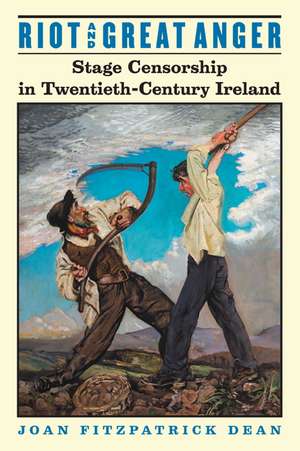Riot and Great Anger: Stage Censorship in Twentieth-Century Ireland: Irish Studies in Literature and Culture
Autor Joan Fitzpatrick Deanen Limba Engleză Hardback – 29 iun 2004
Joan FitzPatrick Dean’s Riot and Great Anger suggests that while there was no state censorship in early-twentieth-century Ireland, the theater often evoked heated responses from theatergoers, sometimes resulting in riots and the public denunciation of playwrights and artists. Dean examines the plays that provoked these controversies, the degree to which they were "censored" by the audience or actors, and the range of responses from both the press and the courts. She addresses familiar pieces such as those of William Butler Yeats, John Millington Synge, and Sean O’Casey, as well as the works of less known playwrights such as George Birmingham. Dean’s original research meticulously analyzes Ireland’s great theatrical tradition, both on the stage and off, concluding that the public responses to these controversial productions reveal a country that, at century’s end as at its beginning, was pluralistic, heterogeneous, and complex.
Preț: 357.83 lei
Preț vechi: 391.52 lei
-9% Nou
Puncte Express: 537
Preț estimativ în valută:
68.47€ • 70.75$ • 56.96£
68.47€ • 70.75$ • 56.96£
Carte indisponibilă temporar
Doresc să fiu notificat când acest titlu va fi disponibil:
Se trimite...
Preluare comenzi: 021 569.72.76
Specificații
ISBN-13: 9780299196608
ISBN-10: 0299196607
Pagini: 240
Dimensiuni: 152 x 229 x 20 mm
Greutate: 0.49 kg
Ediția:1
Editura: University of Wisconsin Press
Colecția University of Wisconsin Press
Seria Irish Studies in Literature and Culture
ISBN-10: 0299196607
Pagini: 240
Dimensiuni: 152 x 229 x 20 mm
Greutate: 0.49 kg
Ediția:1
Editura: University of Wisconsin Press
Colecția University of Wisconsin Press
Seria Irish Studies in Literature and Culture
Recenzii
“This study of the twin traditions of protest and freedom in 20th-century Irish theater will be invaluable in collections supporting study of Irish culture, Irish literature, and modern theater in general.”—Choice
“Essential, not only for the very useful bibliography, but for the insights that [Dean] gives us into the still-volatile world of Irish audience reaction.”—Irish Literary Supplement
"A very original and important contribution to the history of twentieth century Irish drama."—John P. Harrington, author of The Irish Play on the New York Stage
“Essential, not only for the very useful bibliography, but for the insights that [Dean] gives us into the still-volatile world of Irish audience reaction.”—Irish Literary Supplement
"A very original and important contribution to the history of twentieth century Irish drama."—John P. Harrington, author of The Irish Play on the New York Stage
Notă biografică
Joan FitzPatrick Dean is Distinguished Teaching Professor of English at the University of Missouri–Kansas City and author of Dancing at Lughnasa, David Hare, and Tom Stoppard: Comedy as a Moral Matrix.
Descriere
Under the strict rule of twentieth century Irish censorship, creators of novels, films, and most periodicals found no option but to submit and conform to standards. Stage productions, however, escaped official censorship. The theater became a "public space"—a place to air cultural confrontations between Church and State, individual and community, and "freedom of the theatre" versus the audience’s right to disagree.
Joan FitzPatrick Dean’s Riot and Great Anger suggests that while there was no state censorship in early-twentieth-century Ireland, the theater often evoked heated responses from theatergoers, sometimes resulting in riots and the public denunciation of playwrights and artists. Dean examines the plays that provoked these controversies, the degree to which they were "censored" by the audience or actors, and the range of responses from both the press and the courts. She addresses familiar pieces such as those of William Butler Yeats, John Millington Synge, and Sean O’Casey, as well as the works of less known playwrights such as George Birmingham. Dean’s original research meticulously analyzes Ireland’s great theatrical tradition, both on the stage and off, concluding that the public responses to these controversial productions reveal a country that, at century’s end as at its beginning, was pluralistic, heterogeneous, and complex.
Joan FitzPatrick Dean’s Riot and Great Anger suggests that while there was no state censorship in early-twentieth-century Ireland, the theater often evoked heated responses from theatergoers, sometimes resulting in riots and the public denunciation of playwrights and artists. Dean examines the plays that provoked these controversies, the degree to which they were "censored" by the audience or actors, and the range of responses from both the press and the courts. She addresses familiar pieces such as those of William Butler Yeats, John Millington Synge, and Sean O’Casey, as well as the works of less known playwrights such as George Birmingham. Dean’s original research meticulously analyzes Ireland’s great theatrical tradition, both on the stage and off, concluding that the public responses to these controversial productions reveal a country that, at century’s end as at its beginning, was pluralistic, heterogeneous, and complex.





